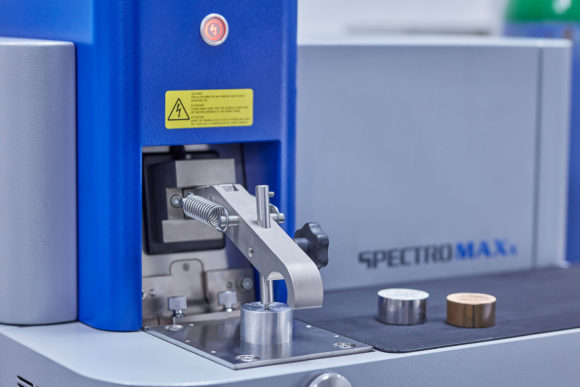Chemical analysis
What is meant by chemical analyses?
Chemical analyses determine the chemical composition of substances. Our materials laboratory specialises in optical emission spectrometry (OES analysis), infrared spectroscopy (IR analysis) and energy dispersive X-ray spectroscopy (EDX analysis).
- OES analysis: optical emission spectrometry is used to determine the composition of substances from the wavelengths characteristic of the elements in the optical spectrum and their intensities. Spark discharge or an electric arc are used for excitation. To detect the element concentrations, the light is split into element-specific wavelengths at the diffraction grating. Detectors then determine the intensity.
- IR analysis: A sample of approximately 1 gram is burnt in a stream of oxygen and using an RF induction furnace. Non-dispersive infrared cells are based on the principle that CO2 and SO2 absorb specific wavelengths within the IR spectrum. Incident IR energy of these wavelengths is absorbed as the gas passes through the IR absorption cells. The concentration of unknown samples is determined relative to the calibration standards. To reduce interference from instrument drift, reference measurements are made with pure carrier gas before each analysis.
- EDX analysis: Thin surface layers are caused to emit X-ray spectra when they are hit by highly accelerated electrons, which are evaluated by detectors.

Range of services of our materials testing laboratory
Our materials laboratory has the testing instruments and equipment for various tests in the field of OES analysis, IR analysis and EDX analysis.
| Procedure | Scope of application |
| OES | Chemical analysis on iron-, aluminium- and copper-based metals |
| IR | Combustion analysis of cast iron to determine C and S contents |
| EDX | Qualitative chemical analysis of surfaces or particles |
Exam dictionary
In the following table, you will find some abbreviations for named designations.
| Abbreviation | Meaning |
|---|---|
| OES | optical emission spectrometry |
| IR | Carbon and sulphur determination by infrared absorption |
| EDX | Energy dispersive X-ray spectroscopy using a scanning electron microscope |
What are the advantages of chemical analyses?
With chemical analysis, you gain knowledge about the qualitative or quantitative composition of metallic or non-metallic material samples. Use our chemical analysis, determine the alloy structure of the base material and identify surface layers.
Are you in need of chemical analysis?
We would gladly support you. Contact us for testing.